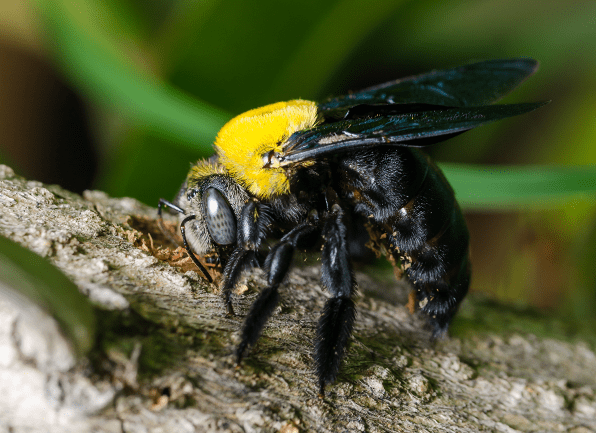A customer recently asked why her home was chosen by carpenter bees. It’s a great question, but the answer has many different variables. So many of us wonder why carpenter bees are such a problem in our area, but maybe not so much at a friend’s home that is only a few miles away – or even a neighbor right next door.
Carpenter bees are unique creatures governed by a set of distinct behavioral patterns. Studying these patterns and exploiting them in our design enabled us to create such effective carpenter bee traps. These behaviors have shown us their preferences and can help us identify why certain homes are more favorable to carpenter bees than others.

Carpenter bees build their homes in wood, so quite obviously the more wood you have, the more attractive your home is. Because the female carpenter bee needs to drill through the wood herself, she will look for wood that will lighten her load. Untreated softwood is her number one preference. Older homes with exposed soft, rotting wood are also very attractive to her, because she can drill through it quickly. However, this won’t stop her from picking out painted or stained wood if it fits the bill.
Existing nests or holes in exposed wood are also a key attractant to carpenter bees. To the female carpenter bee, this means less work and more immediate shelter. If a female is able to find an unoccupied nest, she will absolutely choose this location. Once in the existing nest, the female will continue to “remodel” and expand the tunnel. This is why carpenter bee infestations need to be handled in a timely manner. If the infestations grow unchecked over the years, the structural integrity of your home could be jeopardized.

Carpenter bee females also search for a location that is well sheltered from the exterior elements and potential predators. Prime locations include eaves and corners of homes where the roof overhangs. Carpenter bees don’t want their tunnel to get flooded with rain or filled with debris. They also don’t want to be easily seen by birds. Unfortunately, they don’t always have the same fear of humans and are glad to choose locations on decks and patio furniture.
If you compare our traps to these insights, it’s easy to see why our traps work. Each trap is made of an untreated softwood. There are pre-drilled holes the exact size of a carpenter bee tunnel which further enhances the appeal to female carpenter bees and encourages them to check out a potential new home. The roof of the traps overhangs the wooden body. This added aspect of shelter also gives the trap points in a carpenter bee’s eyes. The piece that really gets the trap working is the pheromone smell omitted by dead carpenter bees. Once the first carpenter bee dies in the trap, the trap becomes much more appealing. Carpenter bees follow that scent to find existing nests that were used in previous seasons.
If you find yourself with carpenter bees, your home undoubtedly has some of these characteristics. Maintaining your wood and repairing carpenter bee damage are great ways to help make your home less appealing. Catching any wandering bees in the beginning of spring with carpenter bee traps is the best way to keep the carpenters out of your wood!









Leave a comment
All comments are moderated before being published.
This site is protected by hCaptcha and the hCaptcha Privacy Policy and Terms of Service apply.